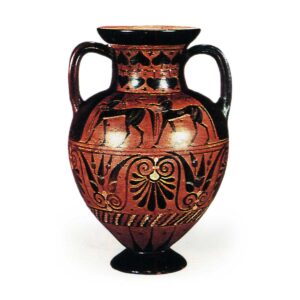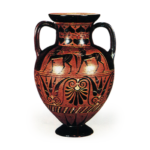
From the beginning of the sixth century B.C. in Greece, Attica welcomed many potters and pottery production began to flourish. Although the geometrical neatness of the vessels remained the same, the themes of the designs became much more human in nature than in Corinthian pottery. In addition, black painting, in which patterns are clearly depicted in black, became popular. The first of these is the famous Francois vase (krater), which bears the names of the potter Ergothymos and the painter Eklytias, as well as 250 images of gods and figures on several levels, with their names also written down in detail. Compared to Corinthian ceramics, animal and botanical motifs are less evident. Attica pottery was mainly exported to the West, where it was filled with olive oil. Amphorae and hudryas were also frequently produced. In the case of black painting, the figures are painted precisely in black on a red ground, and the fine lines of detail are represented by inscriptions. The black paint was made from clay with a high iron content, which was first dissolved in water to separate the heavier particles and then alkali was added. The molded vase is first covered with slip on one side, and then the pattern is painted on top of the slip. The pattern was first outlined and then filled in. Finishing touches of red, white, brown, yellow, etc., and engravings were added later, sometimes using stamps. Firing was first done in an oxidizing fire with good ventilation, then switched to a reducing fire, and finally to an oxidizing fire. To prevent oxidation of once-reduced areas, the areas should be painted thickly. However, if the desired color could not be obtained by this method alone, it was sometimes fired a second time. In the early years, many of the paintings depicted myths related to Dionysos, but everyday work and life were also themes. Among the painters known are Amasis, Exekias, Scythus, and Nearchus. From the end of the 6th to the 5th century B.C., the patterns became more detailed and the compositions were more in keeping with the vessel forms. Kimon of Cleonai is said to have begun the use of precise, highly realistic depictions and perspective painting. The amphorae of the Athenian Festival in Athens are known for their almost unchanged shape. It was decorated with the Athenian goddess, birds, beasts, and the god Nike, the god of victory, and was inscribed with the meaning of the Athenian games and was given to the victors of martial and equestrian arts with sacred oil. The design was simple at first, but gradually became more ornate, and continued to be used until the end of the 4th century BC. The winners each took their prizes back to their hometowns, and they have been found in many places.








